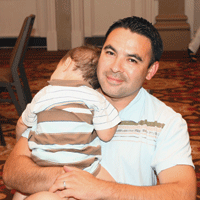Headlines about the US population in the past 30 years keep stating the obvious: The Hispanic population is growing. The total Hispanic population surpassed 50 million in 2011—that’s one-sixth of the total US population. By 2060, the population is projected to grow to 31% of the nation’s total, according to a March 2011 tabulation of US Census data by the Pew Research Center.
This trend is occurring not only in states already known for large Hispanic populations, such as Florida, Texas and California, but also throughout the South and Midwest, says the Pew Research Center’s Hispanic Trends Project, a nonpartisan think tank on social and demographic trends. About 37.6 million people older than age 5 speak Spanish at home. In fact, after English, Spanish is the most popular language in the US, according to another Pew Research Center report, the 2011 American Community Survey.
Nearly every industry that serves the public must change the way it communicates to reach the growing Hispanic population, including the National Hemophilia Foundation (NHF). “It’s not just the fastest-growing population. It’s also one of the most underserved,” says John Indence, NHF’s vice president for marketing and communications.
“There are NHF chapters out there—in Arizona, California, Colorado, Florida and Texas—that are doing an extraordinary job of reaching out to and serving the Hispanic community,” Indence says. “The voice from this community is getting louder. NHF needs to understand what issues relate to them so we can do a better job of supporting them.”
NHF is committed to serving Hispanic families. Sweeping overhauls of some of its main educational vehicles, including websites, publications and educational events, will target Spanish-speaking families affected by bleeding disorders. “We want to be the leader in providing resources to our Hispanic families,” Indence says.
Taking the lead means listening to those on the ground—social media followers, local chapter leaders and hemophilia treatment centers (HTCs)—who have urged NHF to essentially become bilingual.
Getting social
Throughout the year, NHF solicits input from local chapters on their needs and strategies to help them advocate for affected Hispanic families in their communities. Feedback from social media engagement has also been a strong catalyst for directing NHF’s outreach efforts. Social media is an effective way to reach Hispanics. The Pew American Life Project reported that 80% of Hispanics use social media, higher than any other ethnic group.

eurobanks/Thinkstock
To tap into that interest, NHF plans to launch Spanish social media platforms to share information and encourage connections among Hispanic families. These new communication vehicles will also help NHF better understand what’s needed on a national level, including political advocacy and information gathering. “We’re starting slowly, but we’re going to do what it takes to focus on the Hispanic community,” Indence says.
Put it in writing
NHF has made outreach efforts targeting Spanish speakers a priority for years now. Print publications have already been translated and distributed at HTCs and local NHF chapters nationwide.
In 2012, the coloring book My HTC and Me was translated into Spanish—Mi CTH y Yo—in collaboration with the US Centers for Disease Control and Prevention (CDC). So far, more than 2,000 coloring books have been distributed to Spanish-speaking patients and families. The book was also recast as an animated video and translated into Spanish.
Guidelines for Growing, a series of age-specific brochures to help families and clinicians understand what to expect as affected children get older, was also translated into Spanish. More than 1,000 of the brochures have been distributed to local chapters that serve large Spanish-speaking populations.
But these were just the beginning of NHF’s attempts to reach out to this community. Now NHF is expanding its efforts a step further, because sometimes translating materials is not enough.
Inclusion at Inhibitor Education Summits

Eric Marquez cradles his sleeping son
Elijah at a 2013 Inhibitor Education
Summit in Nashville, Tennessee.
About 15%–20% of people with hemophilia will develop an inhibitor, an antibody to infused factor product., reports the CDC. Further, Hispanics have twice the rate of developing inhibitors as Caucasians, says Connie Miller, PhD, a genetics researcher at the CDC. She is head of a project that aims, in part, to determine which genetic mutations lead to inhibitors.
Maria Santaella, RN, MSN, works with a large population of affected Hispanic families as a nurse coordinator in the University of Miami Department of Pediatrics. In her experience, Hispanic families were not benefitting fully at NHF’s Inhibitor Education Summits. These annual meetings allow families to gather in one place to receive the latest health tips and research on inhibitors.
Although Spanish translators were available during the inhibitor summit presentations, many of the families still struggled with basic information. “We realized the Spanish speakers weren’t getting what everyone else was getting,” Santaella says.
The Spanish families weren’t posing questions, asking presenters to repeat something or connecting with other families like the English-speaking attendees. “If they didn’t understand something, that was the end of it,” Santaella says. Families returned home feeling even further isolated from the bleeding disorders community.
Special sessions
Pharmaceutical company Novo Nordisk also noticed the need for additional education. In 2010, it offered a national grant for the first Conferencia Educativa Sobre Inhibidores, an inhibitor summit for Spanish-speaking families. All of the presentations and activities were taught by bilingual or native Spanish-speaking medical experts on bleeding disorders.
During a meet-and-greet session, family members shared their reasons for attending. Many were crying, says Christa Dardaganian, director of educational strategy at NHF. “They finally had an opportunity to be on equal footing and learn from people who understood them.”
This understanding extends beyond language into cultural nuances. One significant cultural difference is that Hispanic families tend to include extended relatives—uncles, aunts and grandparents—in the affected person’s care, not just parents.
The 2013 Spanish Inhibitor Education Summit, held in Miami last June, had 106 attendees from 22 families. More than 75% of the affected people there were under age 17. Thanks to the Novo Nordisk grant, the summit accommodates everyone, providing for travel expenses, food and lodging. This ensures that lower-income and undocumented families, and some traveling from Puerto Rico and Guatemala, attend.
The Spanish inhibitor summit topics address a mix of clinical and psychosocial challenges. “It was like they were hearing this information for the first time,” Dardaganian says. “It’s very different to hear the information in your own language, versus having it translated.”
The information has helped the attendees build their knowledge base, Santaella says. Now they are better able to make more informed decisions about caring for themselves or their affected relatives. They are also forming a niche community. “They’ve become friends,” Santaella says. The moms in particular swap phone numbers and stay in touch. “That’s priceless.”
The 2012 and 2013 Annual Meetings provided Spanish-only sessions for Hispanic attendees. A rap session gave them access to Spanish-speaking members of the bleeding disorders community. The evaluation results included feedback such as: “very interesting,” “very clear” and “give more time.”
At the 2014 Annual Meeting, NHF will offer Spanish-speaking roundtables for participants to choose which topics to discuss. “We’re learning what the Hispanic community needs at a national level,” Indence says. “Then we can create the right programs and services to meet their needs.”
Click here for Spanish
More than half of the families who attended the Spanish-speaking inhibitor summit found out about it from a website or via email. Because the Internet is such a powerful vehicle for disseminating health information, NHF’s priority in 2014 is to convert the most relevant Web content into Spanish.

Dmitry Rukhlenko/Thinkstock
The Steps for Living website has already taken the lead on that. With Hispanics now accounting for more than one in four people who seek information online about health conditions, according to the Health Online 2013 report from the Pew Research Center, NHF decided to convert the site to Spanish. The website, launched in May 2011, offers in-depth information on living with a bleeding disorder at various stages in life.
An outside firm that specializes in linguistic and cultural translation ensured that the Spanish content was not only grammatically correct and medically accurate, but also written at an understandable literacy level.
“Treating and managing bleeding disorders is complicated to understand. It’s much harder for someone with limited English proficiency,” says Ayana Woods, NHF’s director of education. “So, we know there’s a need to make this information available in Spanish.”
After going live with more than 400 pages of content in October 2013, Steps for Living has become one of NHF’s most popular sites, Woods says. Though a large portion of the website has already been translated, a complete Spanish version will be available in May, with more videos to follow.
In April, NHF launched HemAware en español at hemaware.org/es. This online section includes nearly a dozen previously published articles translated into Spanish. In the future, new translated stories will be added monthly. Spanish speakers can also find new Facebook (bit.ly/HAespanol
Facebook) and Twitter accounts in Spanish (bit.ly/HAespanolTwitter).
Translating Steps for Living and HemAware articles, and NHF’s other efforts to reach out to the Hispanic community are about more than simply catering to diversity. They’re addressing a public health issue. “When people get medical information they can understand, they are more likely to adhere to medications and make healthier decisions,” Woods says.

